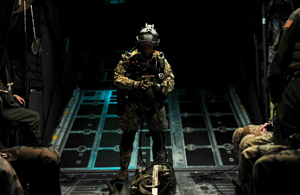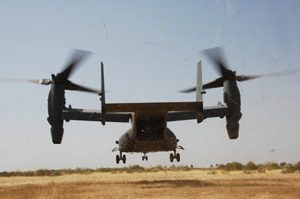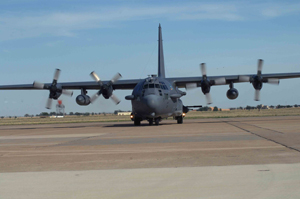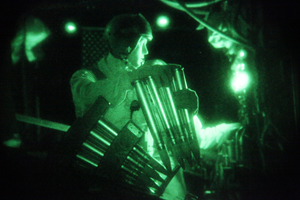Not long ago, several AC-130U gunships were idling on the ramp at Hurlburt Field, Fla., the home of Air Force Special Operations Command headquarters. This was as a notable event; gunships are rarely seen there in groups anymore.
The Spookys haven’t changed bases. Rather, these deadly, cannon-firing aircraft have become some of the busiest in the Air Force, deploying to many parts of the world. They are most prominent, however, in the wars of Iraq and Afghanistan, where they are in constant demand and perpetually in motion. They almost never come home.
The Spooky gunship fleet could be said to represent Air Force Special Operations Command. It is heavily tasked for today’s conflicts. Yet it is also trying to manage an expanding mission set, growing inventory, and much needed weapon modernization.
USAF’s special operations forces contribution is of enormous importance to the war effort. The Air Force is developing irregular warfare capabilities by investing in specialized airlift, newer close air support assets, counterinsurgency training, and more aircraft suited for continuous intelligence-surveillance-reconnaissance flights over the discontinuous battlespace.
 |
|
The Pentagon’s Fiscal 2011 budget proposal allocates $6.7 billion over the next five years for recapitalization and growth of Air Force special operations forces. A large chunk will go to recapitalize the command’s air assets. Special operations forces have experienced major growth since the 9/11 attacks, but the air component has lagged.
“People think we’ve invested a lot of money in special operations, and so we have fixed it,” Lt. Gen. Donald C. Wurster, AFSOC commander, once observed. “We have not invested a lot of money in the air. … We are starting to.”
Capt. Brian Chesko, a navigator who has accumulated about 1,400 flight hours, says the next 18 months will be important for all Spooky crews. Chesko says he has averaged two to three deployments a year, but notes that AC-130 gunners are deployed even more often than that.
Even as Chesko spoke, a contract airliner waiting nearby prepared to transport a new batch of Air Force SOF troops back to Southwest Asia. Some had completed critical training tasks days earlier.
Since September 2001, the size and scope of the SOF contingent has undergone a transformation. The wars have pulled in the command’s men and aircraft, ranging from the AC-130 for close support to MC-130s for specialized tanker support and the CV-22 Ospreys for fast and flexible mobility. This leaves precious little time for home-station training or recovery.
“We have a wide diversity of operations right now,” said Col. Ray Chapman, the command’s deputy director of operations and vice commander of 23rd Air Force.
Though operating tempo remains high, he went on, AFSOC seeks a balance between meeting immediate combat demands and taking care of airmen longer term.
There is a lot of balancing going on now, between growth in both requirements and on forces in the field and the future demands anticipated, Chapman said. “We’re getting these weapons systems and turning them as fast as [we] can.”
Gunship crews may be fine deploying two to three times a year for five years, but there comes a point where that level of activity and time away from home begins to cause damage. The squadron looks for opportunities to put heavily used airmen in wing or operations group positions so they can spend some time at a lower tempo before coming back to their primary specialties at a later date.
“I would not say it’s an easy ops tempo,” even for the airmen that AFSOC manages to protect somewhat, said Lt. Col. Brenda Cartier, commander of the 4th Special Operations Squadron. “It’s a sustainable ops tempo. Sustainable means we can continue to meet the requirements.”
The squadron possesses 17 AC-130Us. On any given day, only about five are available for operations. Most of the U models are receiving new center wing boxes, and others are beginning their programmed depot maintenance cycle earlier than anticipated. Fleet management is a “day-to-day” task, said Cartier. This makes it even harder to balance training and operations.
“We’ve worked hard to replace old aircraft that have flown at up to three times their planned utilization rates,” Chapman said. “In five years, we’re going to look completely different.”
Plans call for Air Force Special Operations Command to request $1.6 billion to begin replacing the fleet’s Vietnam-era AC-130H Spectre gunships with modern J models. The new gunships will be bought between Fiscal 2011 and Fiscal 2015.
In all, the command will acquire 16 new J gunships—based on the MC-130J airframe and fitted with a strike package. This will increase the size of the fleet to 33 aircraft, a net growth of eight after accounting for the retirement of eight Spectres.
A Growth Field
Having outgrown its Florida Panhandle home, Air Force Special Operations Command is now shifting many CONUS assets to Cannon AFB, N.M., where the 27th Special Operations Wing stood up in October 2007.
The command will get all 50 of its Ospreys by 2015. For the time being, operators are doing their best to balance training demands back home with combat needs with a small fleet.
The Osprey offers SOF teams twice the speed of traditional rotorcraft, said Lt. Col. Matt Glover, operations officer for the 8th SOS at Hurlburt. This allows teams to move twice as far in a single period of darkness—or get somewhere in half the time—a huge combat benefit.
 |
A CV-22 Osprey takes off during a joint training mission near Bamako, Mali. (Photo by Sgt. Kieran Cuddihy)
|
The 8th SOS saw its first CV-22 combat deployment to Iraq last year, where a great deal of information was gleaned about the tilt-rotor in combat conditions. While downwash from the powerful twin rotors remains a “significant issue” and some small fixes had to be made, the aircraft have proved overwhelmingly effective, Glover said.
On April 9, disaster struck the CV-22s. One of the Ospreys crashed in southern Afghanistan, killing four. An accident board is investigating the cause.
The big challenge for the future will be training new aircrews. The pool of experienced helicopter crew members is drying up. The last MH-53 was retired in 2008 and the Air Force’s HH-60 and UH-1 communities can’t give up too many more bodies to help cover deficiencies, Glover said.
For its airlift, Air Force Special Operations Command seeks 37 MC-130Js to replace 10 Vietnam-era MC-130Es and 23 MC-130Ps. The new specialized tankers are enablers, said Col. Bill Lane, the command’s deputy director of plans and programs.
Elsewhere in the SOF community, Army and Navy components have experienced 25 percent growth since 2006, reported Lane. This means the Air Force SOF establishment is attempting to catch up in critical areas: mobility, armed overwatch, ISR, and so forth. There are gaps, both short and long term, that Air Force Special Operations Command is attempting to fill.
US Special Operations Command has repeatedly pressed for light mobility and strike capability to support its small teams of operators at war around the world. A smaller gunship variant, known as the Stinger II, based on the C-27J, was proposed but later canceled. As recently as last year, AFSOC had no recapitalization plans for gunships.
However, the command hopes to fill a portion of the gunship gap by the end of this year. It will do so by modifying existing aircraft. MC-130W Combat Spear aircraft are being equipped and tested with the precision strike package, an upgrade to the modified C-130, which will give the aircraft armed overwatch tools to assist SOF teams in combat.
In March, Adm. Eric T. Olson, commander of the multiservice US Special Operations Command, said the Air Force is fielding four aircraft fitted with the package. Dubbed “Dragon Spears,” the former tankers of the 73rd SOS at Cannon, will receive sensor upgrades, a standoff precision guided munitions system, a 30 mm gun, and new sensor and communications gear.
The retrofitted tankers are a temporary fix for AFSOC’s stressed gunship fleet in the near term, and are making up for the cancellation of the “light gunship” concept.
Chapman said the MC-130 can perform cargo and security assistance missions in addition to pop-up strikes. The aircraft “makes its money” by providing persistence over the battlespace, he added.
Battlefield awareness capabilities have received close scrutiny recently. The command now boasts its own MQ-9 Reaper squadron in the 33rd SOS (activated May 29, 2009 at Cannon) plus the 3rd SOS Predator squadron and Reserve associate unit, the 2nd SOS. Chapman noted AFSOC is also aggressively expanding its use and proficiency with small unmanned aerial vehicles, such as the Raven, often utilized by security forces and special tactics airmen.
 |
An AC-130H Spectre gunship taxis onto the flight line at Hurlburt Field, Fla.(USAF photo by A1C Jams Bell)
|
AFSOC is planning to add a small-UAV schoolhouse to the Air Force Special Operations Training Center at Hurlburt later this year, preparing air commandos to use the small UAVs for route reconnaissance, relief operations, and in tactical engagements with other SOF troops.
Beyond the gunships and heavy lift, one of Air Force Special Operations Command’s largest growth areas is in “nonstandard aviation”—or NSAV in Hurlburt parlance.
Hurlburt’s 319th SOS, which flies the U-28A, a variant of the single-engine Pilatus PC-12, is a pioneer in the field. Air Force Special Operations Command is tight-lipped, as are the U-28A’s small crews, about the aircraft. Its ability to operate on short and unimproved surfaces, and suite of advanced radar, communications, and navigation tools make the U-28 ideal for small, secretive missions.
In 2008, a second nonstandard aviation unit stood up—the 318th SOS at Cannon. It is home to the PC-12 and will soon add additional light and medium twin-engine aircraft. By Feb. 10, the squadron had one of 10 planned M-28 Skytrucks—a Polish light twin-engine transport based on the Antonov An-28 design.
In total, the NSAV program will deliver 20 Pilatus aircraft, 10 M-28s, and 17 medium aircraft by 2012. Chapman noted the requirement came from the field—small operations detachments were often using contract airplanes to get to and from isolated and remote locations.
A Grass Hut in the Sahara
“These are very sensitive missions which require a low profile and not [the] large footprint that a C-130 or C-17 would necessitate,” he said. The NSAV field has grown quickly through streamlined acquisition processes and the relative simplicity of the aircraft. The aircraft are needed not only in Southwest Asia, but across Africa, the Pacific, South America, and other combatant commands.
The “small footprint” approach is critical to another expanding piece of AFSOC’s program—aviation foreign internal defense, performed exclusively by the 6th SOS.
The 6th SOS’ combat aviation advisors work with allied militaries across the world to develop their aviation assets into effective partners. Advisors are proficient in a range of languages and aircraft, from UH-1 Hueys to Mi-17 helicopters common in former Soviet-bloc nations, to the BT-67, a retrofitted version of the venerable DC-3 twin-engine prop transport still used by many small militaries across the world.
Lt. Col. Joseph Michalek, commander of the 6th SOS, said, “For us, the weapon system is the advisor.” The advisors come from all across the force and include security forces, mechanics, and intelligence personnel but are trained to be interchangeable.
Between a four-phase training program encompassing advanced SOF skills, flying, protocol, exercises, and other tasks, it can take two years to develop a fully qualified CAA. Advisors work under some of the most autonomous conditions possible and must be almost completely self-sufficient—separate from what Michalek called the “Fortress America” operations of general-purpose forces in Iraq or Afghanistan.
If the mission calls for “living in a grass hut in the Sahara and sleeping on a mat, … that’s what we do to make the mission effective,” Michalek said. The hard part is taking functional experts and turning them into adaptable, flexible advisors.
MSgt. Ace Jones, a veteran of multiple advisory deployments with the Philippine armed forces, said much of his team’s work is building durable relationships and helping allies integrate their own militaries.
Advising is not just about irregular warfare and finding bad guys, Jones noted. CAA work protects allied governments by allowing them to project power, authority, and aid. “If they can’t project [to meet] their country’s civil needs, … that shows a lack of governance,” he said.
A great deal of the 6th SOS’ work involves developing mobility assets in areas of Asia and Africa with vast spaces and little infrastructure. When disaster strikes, air assets can swing into action.
The 6th SOS is authorized to roughly triple in size, but this takes time. “We are still growing to meet our authorizations,” Michalek said. Airmen who began training in 2007 didn’t make it to the operational level until 2009 because “they have to meet our standards.”
In the years ahead, Michalek hopes to bring back experienced airmen who were in the unit earlier in their career. They could provide institutional knowledge and help train a new generation of advisors.
“We like to say we are a tactical unit on a strategic stage. Everything we do has a strategic implication, and if we do something bad, we may never be invited back to that country again,” he added. Getting the right people with the right temperament is critical to the unit’s continued success.
At the same time, the command is modernizing its training and education regimes to better support operators.
To accomplish this, the command consolidated training and education under the Air Force Special Operations Training Center at Hurlburt. The center was activated in October 2008 at the direction of AFSOC commander Wurster, to take training out of operational squadrons to give it a permanent home under a single organization.
“The problem” said Col. Mark B. Alsid, AFSOTC’s commander, was that oddly enough, “the old institution didn’t institutionalize training.”
Buckling under the post-9/11 operations tempo, the old training arrangement was unsustainable, AFSOTC officials say.
 |
A gunner aboard an AC-130 Gunship loads rounds into a Bofors cannon during a mission supporting ground troops in Afghanistan. (DOD photo by SSgt. Billie J. Nelson Jr., US Army)
|
For example, the 19th SOS—Hurlburt’s flight training squadron—was formerly under the auspices of the 1st Special Operations Wing. Rather than focus on deploying its operators downrange, the squadron frequently juggled training obligations with combat requirements of the 1st SOW. This meant having to spend valuable resources and manpower training up and qualifying personnel—rather than focusing on deploying its operators into combat, Alsid noted.
Still under way, the massive reorganization is drawing all of Air Force Special Operations Command’s training, recruitment, assessment, and indoctrination activities under a single roof—from combat aviation advisors to battlefield airmen pilots and support and administrative personnel.
Col. William D. Andersen, commander of the center’s Air Force Special Operations School is responsible for conducting introductory training for air commandos and combat aviation advisors. US Special Operations Command receives less than two percent of the Pentagon’s budget, he points out, but almost all of its assets are low density, high demand. With the growth in operational requirements, AFSOC’s support and training infrastructure needed to be changed to reflect reality and help sustain combat forces better, he said.
Lt. Col. Steven Spanovich, a veteran combat controller and commander of the center’s Special Tactics Training Squadron, heads up advanced training for in-demand battlefield airmen. Security forces, pararescuemen, combat controllers, combat weathermen, and others must go through Spanovich’s squadron after their initial training for the advanced skills needed in operational units.
Arriving at the STTS as “three levels,” they leave as “five levels” after a battery of specialized skills training, courses, and conditioning, depending on what color beret they wear. “When we get them, they’ve graduated high school,” Spanovich explains. “Here, they’re in college.”
Training activity takes up a large—and growing—chunk of resources for the expanding command.
Just prior to 9/11, the flight training squadron graduated a little under a thousand students a year, said Lt. Col. Dag Anderson, commander of the 19th SOS. In 2009, the number was just under 4,000 as the squadron has taken on the addition of more ambitious and effective flight simulators as well as keeping up with demands for newer light aircraft crews and combat aviation advisors.
The Indirect Approach
In 2009, the squadron established a new training pipeline for AFSOC’s PC-12 and U-28 light aircraft while divesting the AC-130H training mission, which was passed to Cannon’s 551st SOS. Anderson noted that around 70 percent of the 19th SOS trainees are out of undergraduate pilot or navigator training, or another initial training pipeline.
Instructor pilots are at a premium. Young AC-130 gunner students, for example, must be able to place 40 mm shells “danger close” in engagements within weeks of graduating from Anderson’s course. “We’re not trying to haze people,” he quipped about the course’s difficulty. “We just haven’t relaxed our standards.”
Cartier said her 330 or so airmen are younger than in previous years but maintain the high standard expected. “We’re getting brand-new folks out of tech school,” she said. “But their talent is second to none. They are the reason we are successful.”
Several command officials pointed out the nature of SOF is one of limited duration and low profile but high impact. This is markedly different from the long duration theater campaigns in Iraq and Afghanistan.
Air Force Special Operations Command’s core skill sets are geared toward time-sensitive operations ranging from earthquake relief in Haiti (where combat controllers helped jumpstart airfield operations earlier this year) to any number of critical anti-terror operations. “Sustained operations are someone else’s bag,” Chapman noted. “We get in, we set things off, and we get out.”
The limited public evidence supports Chapman’s observation. Over the past several years, military statements and open sources have documented limited SOF strikes in places such as Pakistan’s frontier regions, Yemen, and East Africa. Targeted operations, military assistance, and advisory work with allies are expected to continue to grow in importance.
“The indirect approach is going to be huge in the years ahead,” Chapman said. “We make our money by operating as a coalition, in partnerships. … If we build up these relationships, you become a better coalition” and a better force.
The 4th SOS’ Cartier said it is a priority to make sure her gunship crews are keeping skills up to perform both conventional warfare and other types of missions.
“We don’t know where we’ll be in six or seven years,” she said, so what might be needed next is never far from her mind. “We have to train to fight in Afghanistan, but we have to look to train for the other fight, the undefined fight. … We have to always keep it in mind.”